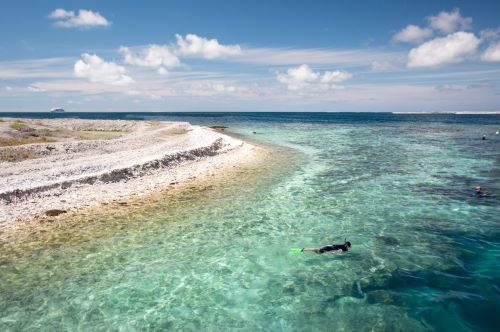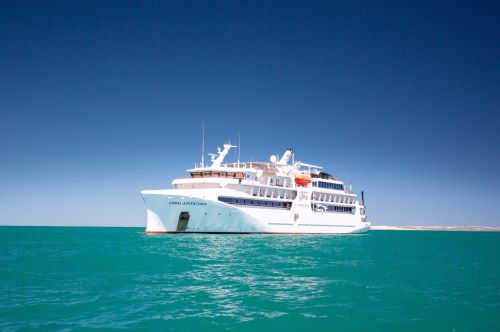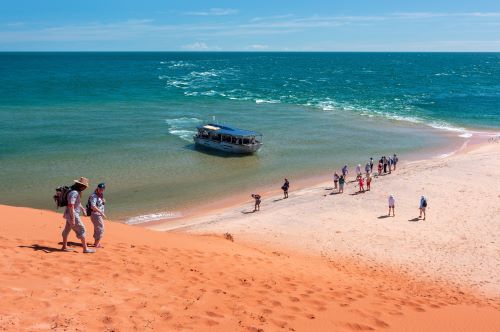Across the top
of Australia
with Coral Expeditions
- Newly released itinerary
- Departs Cairns to Fremantle
- All excursions with the Expedition Team included
- Members save $500 per person^
Australia’s north-east coast is a showcase of natural beauty and cultural richness. Journey through the pristine waters of the Great Barrier Reef, home to vibrant marine life and remote sand cays. Continue north to Cape York and the Torres Strait Islands, where you’ll encounter deep Indigenous traditions and spectacular scenery. Visit historical and cultural sites with guidance from local rangers. Then, traverse the remote Kimberley coast — a land of dramatic rock formations, hidden gorges, and thriving wildlife. Discover ancient rock art, marvel at towering 80-metre sandstone cliffs, and snorkel among colourful coral reefs.



The fleet
Coral Expeditions' small ships and unique itineraries take you to some of the most beautiful and remote regions of Australia, the Asia Pacific, South Pacific and the Indian Ocean. On board you will discover a personalised style of cruising. With ships carrying only 72 to 120 guests, you can say goodbye to queues, long waits, and assigned seating. Instead, enjoy a relaxed, convivial atmosphere shared with like-minded explorers.
Without crowds to worry about, the chefs can prepare small-batch meals made with Australian ingredients. Where possible, they procure from local food markets. The shallow draft and high manoeuvrability of the purpose-designed expedition ships let you get closer on coastal adventures to explore the sheltered bays and hidden inlets inaccessible to larger ships.
Coral AdventurerLaunched in April 2019, Coral Adventurer is a tropical expedition ship purpose-designed to access remote wilderness shores in Australia and internationally, that are often inaccessible to large cruise vessels. Carrying a maximum of 120 passengers – Coral Adventurer is purpose-built to take you closer to unspoiled vistas in comfort, style, and safety.
- 120 guests
- 2 bridge deck ‘Cairns’ and ‘Darwin’ suites
- 60 spacious staterooms – all outside facing
- Over 1000 square metres of open deck space
- Wrap-around promenade deck with panoramic views
- Shallow draft to access remote destinations
- Two trademark Xplorer tenders
- Six zodiacs for more intrepid exploration
Inclusions
- Daily excursions and activities led by expert guides
- Special hosts delivering interpretive programs
- Use of Xplorer, Zodiacs and Kayaks
- Snorkelling & SCUBA equipment (SCUBA diving at an additional cost)
- Daily lectures and briefings with Guest Lecturers
- All meals, chef-prepared on board
- Captain’s welcome and farewell events, and open bridge access
- Premium wines, beers, spirits and soft drinks from 11am - 10pm daily
- 24-hour barista-style coffee and tea station
- All entrance fees to National Parks, ports, traditional owner fees and charges imposed by governing authorities
- Tips and gratuities
- Use of all onboard facilities, incl. a reference library
- Your expedition photos captured during the voyage
- Post-cruise transfers
- Wifi Access – Standard speed connectivity enabling email, social image sharing, web browsing and messaging
Day 1: Cairns
Arrive at Trinity Wharf (berth to be advised) at 4:00pm, where there is time to settle into your stateroom before our 5:00pm departure.
Take the time to become acquainted with all the facilities onboard Coral Adventurer before joining your fellow explorers for Captain’s Welcome Drinks. Afterward, enjoy your first delicious dinner as we cruise toward Lizard Island.
Day 2-26: Across the Top of Australia
Days at sea
Relax on deck as we spend a day at sea, with onboard presentations from our Guest Lecturers, workshops, and demonstrations.
Lizard Island (Dyiigurra)
We spend a whole day at Lizard Island where there is time to hike to the summit of Cook’s Look and enjoy the same view Lt. James Cook did when searching for safe passage through the maze of coral reefs. Snorkel over giant clam gardens from the beach at Watson’s Bay, relax on the white-sand beach beneath shady she–oak trees and learn about the tragic story surrounding Mary Watson. There will be an opportunity for water activities and an Xplorer cruise.
Stanley Island (Yindayin) & Davie Reef
Visit Stanley Island in the Flinders Island Group and take a walk to view the isolated Endaen Aboriginal rock art guided by a traditional owner who will offer an interpretation. The art here depicts the first sailing ships to visit Queensland shores. At Davie Reef enjoy swimming, scuba, snorkelling or glass-bottom boat tours and see brown boobie bird colonies at Davie Cay.
Restoration Island
Visit Restoration Island or Resto, as the locals call it. Here Captain Bligh, of the infamous Mutiny on the Bounty, made his first landfall after a long ocean crossing from Tonga, in May 1789. Restoration Island was so named by Bligh as he landed there on Oak Apple Day (anniversary of King Charles II’s restoration) and the abundance of oysters and native fruits available for the crew.
Today Restoration Island is not just a National Park; one-third of the island is leased to David Glasheen, a former mining tycoon, who, after losing his fortune in the Black Friday market crash, decided to live a solitary existence on the island, and has done so for over two decades. It is an idyllic coastal island with a granite and volcanic peak 116 metres in height and a beautiful shark tooth-shaped beach spit where guests will enjoy water activities and time to explore the island.
Thursday Island (Waiben)
Immerse yourself in the ancient Torres Strait Islander culture with our unforgettable traditional dance, storytelling and musical show.
Badu Island & The Tip of Cape York (Pajinka)
At Badu, we visit the indigenous art centre to watch printmakers at work, with the opportunity to purchase prints that catch your eye.
In the evening, set foot on the northernmost point of Australia – the tip of Cape York. Surrounded by a glistening sea and bathed in the glow of twilight, we enjoy sundowner drinks and the company of like-minded explorers as we relax and watch the sun gently sink below the horizon.
Yirrkala Art Centre (Gove Peninsula) & Bremer Island (Dhambaliya)
Visit the spectacular Buku-Larrnggay Mulka Centre at Yirrkala, outside of Nhulunbuy. Here, the Yirrkala Art Centre represents Yolŋu artists from around the region.
Established in 1976 as an act of self-determination, the art centre has forged a vibrant path for Yolŋu contemporary art. The museum built in 1988 houses a collection of works detailing historical artefacts and important moments, including the Message Sticks from 1935 and the Yirrkala Church Panels from 1963.
After lunch back onboard Coral Adventurer, we make the short journey to nearby Bremer Island. The Xplorers will drop us off on the curving golden beach of this idyllic tropical retreat. Here at the Banubanu Beach Resort, owner Helen will welcome us on the beach. Helen an Aranda woman from Alice Springs along with her husband Trevor had discovered this location over ten years ago and fallen in love with its charms. Obtaining the permission of the local community and the senior matriarch they had over the years established this tasteful seven-unit resort and the fine detail of the landscaping, infrastructure and facilities along with excellent staff service at the tasteful café was a credit to their vision, work and enterprise of their staff and helpers. Guests will be enjoying the ambience with swimming, snorkelling, walking the trail or relaxing in the café and plunge pool.
Darwin
We arrive into Darwin Port on the 26 October 2025 at 12:30pm. While in port, guests can enjoy free time to have dinner ashore and catch up with any friends or family they have in the area.
We will be departing Darwin at 8:00am on the 27 October 2025.
Tiwi Islands
Experience a traditional welcome ceremony and morning tea (damper and billy tea). On a guided tour, learn of the culture and history of the Tiwis as we explore the museum and the old mission precinct.
Visit Tiwi Design, one of the oldest and most artistically diverse art centres in Australia and produces of ochre paintings on canvas and bark, ironwood carvings, screen printed fabrics, ceramics, bronze/glass sculptures and limited-edition prints.
King George River
Cruise down the scenic King George River, through steep-sided gorges carved by a flooded river system that carved a swathe through the Kimberley landscape 400 million years ago. We will take the opportunity to get up close and view the honeycomb erosion patterns of the 80m tall sandstone cliffs.
A Day Of Rock Art
Today we will land at either Jar Island, Swift Bay, Wollaston Bay or Bigge Island. Each of these locations are home to fantastic Wandjina and Gwion Gwion Rock Art (Bradshaw) galleries.
Stretch your legs and explore the magnificent sandstone structures, providing an abundance of rock shelters. On the walls of these shelters is where we will find examples of this rock art.
Prince Frederick Harbour & Hunter River
Prince Frederick Harbour is one of the Kimberley’s most spectacular locations at the southern end of York Sound. The harbour is dotted with islands lined with mangroves and monsoon rainforests, set against a backdrop of ochre-hued escarpment. White-bellied sea eagles and other birds of prey are often seen here, and at low tide, expansive mudflats reveal large populations of mudskippers and mangrove crabs. We will take our Xplorer tender vessels on a cruise up Porosus Creek where there is a very good chance to see crocodiles in amongst the mangrove banks.
Ashmore Reef
The territory of Ashmore and Cartier Islands is made up of the West, Middle and East Islands of Ashmore Reef, as well as Cartier Island and the surrounding 12 nautical mile territorial sea. These islands are uninhabited, making them the perfect location for seabird breeding. Each year around 100,000 seabirds flock to the marine park’s three tiny islands.
The reef here boasts a wide diversity of marine life, including over 70 fish species and 255 varieties of coral. To protect this reef, the Australia Government declared the Ashmore Reef National Nature Reserve in 1983. The islands also have a significant marine turtle nesting area and migratory bird populations.
Here we will spend time birdwatching, swimming and snorkelling the pristine reef.
Winyalkin
Explore the sandstone caves of Wollaston Bay or Wollaston Creek. This mass of weathered tunnels, arches and columns form a labyrinth-like maze and was once an Aboriginal midden. Another option while anchored at Winyalkan Bay is a visit to a series Wandjina and Gwion Gwion rock art galleries at Swift Bay.
Montgomery Reef (Yowjab)
Montgomery Reef is a biologically diverse area covering over 300 sq km and was named by Phillip Parker King. Twice daily, as the sea recedes in mammoth 11m tides, Montgomery Reef rises from the Indian Ocean in a cascade of rushing water revealing a flat-topped reef pockmarked with rock pools and rivulets.
As the reef emerges, we get up close in our Xplorer and Zodiac inflatable tenders to witness the spectacle as our Expedition Team share their knowledge on the formation of the reef and the myriad wildlife. Opportunistic birds take advantage of the emerging reef, feeding on marine life left exposed in rock pools. Turtles, dolphins, dugongs and sawfish too are also attracted to feeding opportunities as the ocean recedes.
The ocean is awash in a swirl of eddies and whirlpools as the moon’s gravitational force takes hold. Then, a few hours later the entire water-borne drama is reversed as the tide comes in and Montgomery Reef disappears below sea level.
Talbot Bay, Horizontal Waterfalls (Garaanngaddim)
The Horizontal Falls are one of the Kimberley’s biggest attractions and are a result of the mammoth 11m tides the Kimberley is renowned for. Naturalist David Attenborough described the Horizontal Falls as ‘one of the greatest natural wonders of the world.’
This natural phenomenon has been created as the ocean thunders through a narrow gorge in the McLarty Ranges. Water builds up on one side and is forcibly pushed through the bottleneck, creating a rushing horizontal waterfall of swiftly flowing seawater. Riding the rapids on our Zodiac inflatable tenders is one of the highlights of our Kimberley expedition cruises.
Talbot Bay is at the heart of the Buccaneer Archipelago, where rocks on the 800 or so islands are estimated at over 2 billion years old. At Cyclone Creek, you will see evidence of massive geological forces in the impressive rock formations.
Lacepede Islands (during turtle season)
The Lacepede Islands are a protected class-A nature reserve and are significant as a seabird nesting rookery for brown boobies and roseate terns. Other species often sighted at the Lacepedes include Australian Pelicans, frigate birds, egrets and gulls. The four low-lying islands are also an important breeding and nesting habitat for green turtles. Cruise the lagoon in tenders and witness the myriad wildlife here.
Rowley Shoals
At the edge of the continental shelf, 170 nautical miles offshore, lie the Rowley Shoals a chain of 3 coral atolls including Clerke, Mermaid and Imperieuse Reefs. The shoals, named by Captain Phillip Parker King, offer some of the best snorkelling and diving opportunities in the world. Their shallow lagoons are inhabited by myriad coral species and marine life, including giant potato cod, Māori wrasse, at least 233 species of coral and 688 species of fish – many of which are not found on other coral reefs. Diving along the outside edge of the shoals one can view colourful soft corals, hammerheads and pelagic fish. Water clarity here is unparalleled, making for superb underwater photography opportunities.
Guided by our onboard marine biologist, snorkel away the day in the coral gardens of the Aquarium at Clerke Reef, or dive along the sheer vertical walls and through coral canyons.
Dampier Archipelago
Consisting of 42 islands and islets, 25 of which are nature reserves; The iron-red islands of the Dampier Archipelago stand in bright contrast to the turquoise waters which surround them. The archipelago not only offers exceptional natural beauty but significant sites for Aboriginal and European Heritage, many of which are in National Heritage Listed Areas. Named after English explorer William Dampier who first visited the islands aboard the Cygnet in 1699; the islands’ earliest inhabitants were the Yaburara people, as is evidenced by the thousands of rock engravings, shell middens and stone arrangements scattered across the area.
There will be ample opportunity to explore the area’s historical and cultural sites under the guidance of the Murujuga Land and Sea Rangers before taking to the azure waters for swimming and kayaking. Birdwatchers will have the opportunity to see several species of migratory waders as well as sea eagles and ospreys. With luck, we may even see the elusive Rothschild’s rock wallaby.
*Please note viewing of aboriginal petroglyphs is subject to approval and guidance by traditional owners of the area, and cannot be guaranteed.
Exmouth & Ningaloo Reef
The World Heritage-listed Ningaloo Reef is the turquoise jewel in the crown of the Western Australian coastline. Spanning over 5,000 square kilometres, this is one of the largest fringing reefs in the world. Its inner and outer reefs create a diverse range of habitats for vibrant corals and more than 500 species of fish. This is also where marine life comes to feed during their migrations, including humpback whales and giant manta rays. It is also a coastline with a fascinating heritage, where lonely whalers battled it out against the elements.
Today you have a choice between two tours:
From Exmouth, take a coach tour to discover Cape Range National Park, enjoy a nature walk at Yardie Creek, and visit the Vlamingh Head lighthouse.
Or visit the educational Ningaloo Centre which prepares you for an incredible experience of snorkelling from the beach at Turquoise Bay, and a boat charter with a local operator to discover the outer reef with the opportunity to snorkel with manta rays and turtles. There may be an opportunity for advanced divers to discover the Navy Pier dive, depending on tides.
Batemans Bay
The remote and well-hidden Bateman’s Bay, just north of Coral Bay, is a much more remote and untouched landscape in comparison with beautiful sand beaches.
Weather permitting, we will make a short landing on the remote Ningaloo coast between Northwest Cape and Shark Bay, for a swim and a beach comb.
Shark Bay World Heritage Area
Explore the Shark Bay World Heritage Area, the first location in Western Australia to receive UNESCO World Heritage status in 1991. This is a region of colourful landscapes, rare flora and fauna, and home to a staggering 35% of all of Australia’s bird species. Walk the Wanamalu trail and view the wildlife and striking contrasts between red sand and turquoise sea.
Cruise past historic Cape Inscription, the site of Dirk Hartog’s landing in 1616.
Abrolhos Islands
The Abrolhos Islands consist of 122 islands, clustered into three main groups, the Wallabi, Easter and Pelsaert Groups. Lying in the steam of the southward flowing Leeuwin current, the marine environment here is a meeting place for tropical and temperate sea life. Common marine mammals include Australian sea lions and bottlenose dolphins, and over 90 species of seabird have been identified. The treacherous reefs around these islands have claimed many wrecks over the centuries, the most famous being the Batavia in 1629 – whose Dutch crew swam ashore only to experience a brutal mutiny.
The Abrolhos islands offer a near-pristine natural environment with a diverse range of marine and terrestrial fauna and flora. This area also offers a rich history including shipwrecks and remnants of early colonial industries such as guano mining and commercial fishing.
Depending on which of the islands we visit, there will be opportunities for a range of activities including visiting historical sites, wildlife viewing and world-class diving and snorkelling sites. The Australian sea lions love to swim and play here.
At the Pelsaert (Southern) group we will have the opportunity to visit Liddon Pearl Farm and crayfishing operations on Post Office Island. Here we learn what is involved with growing the pearls, learning the different shells and pearl categories, and how the different types of pearls are set. We will also have insights into the renowned cray fishing industry of the island, from the family who has been in the Abrolhos for 4 generations.
Fremantle | Embarkation & Disembarkation
Disembarkation: Our Across the Top of Australia voyagers will bid farewell to new-found friends, the Master and crew, disembarking at 5:00pm on 12 November 2025..
This itinerary is an indication of the destinations we visit and activities on offer. Throughout the expedition we may make changes to the itinerary as necessary to maximise your expeditionary experience. Allowances may be made for seasonal variations, weather, tidal conditions, and any other event that may affect the operation of the vessel. Coral Expeditions suggests that you do not arrive on the day of embarkation or depart on the day of disembarkation due to any changes that may occur in scheduling.
Travel dates
2025: 17 October 2025
| Cabin | Standard Price Per person, twin share |
RAC Member Price Per person, twin share |
|---|---|---|
| Promenade Deck Stateroom | From $32,990 | From $32,490 |
*Advertised price is based on twin share. Limited sole use occupancy available. Please enquire with your RAC travel consultant for current availability and pricing for higher stateroom categories.
*Terms & Conditions apply. Prices are per person, listed in Australian Dollars (AUD) and include GST. A non-refundable 20% deposit is required at time of booking, balance of the fare is due 90 days prior to departure. A $500pp date change fee for changes made more than 90 days before departure applies. Date change within 90 days of departure is considered a cancellation and standard Cancellation Policy applies. Further Coral Expeditions terms & conditions apply. Prices are correct as of 23 June 2025. Pricing and availability subject to change without notice. Please contact your RAC travel consultant for full terms and conditions.
^RAC members save $500 per person: Discount applies to all voyages with Coral Expeditions. Combinable with Xplorer’s Club benefits only, not combinable with any other offer. Offer ends 01 January 2026.
General RAC Travel terms and conditions apply.
